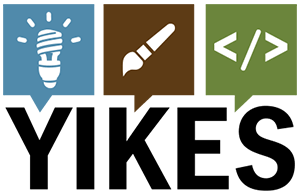Happy New Year. We hope you find these New Year’s Resolutions helpful.
1. Create a Website Inventory
Domain Name(s)
You can find helpful information at whois.domaintools.com.
- Who is your domain name registrar? This is the company that registers your domain name(s) (eg, Network Solutions, Hover.com, GoDaddy).
- When does it expire? This is very important to keep note of.
- Do you have the account login information?
- Is the Credit Card on file up-to-date?
- Who controls it? Check to see who is listed as the owner, administrative and technical contacts.
Example
Domain Name: YIKESDEV.COM
Registry Domain ID: XXXXXXXXXXXXX
Registrar WHOIS Server: whois.tucows.com
Registrar URL: http://tucowsdomains.com
Updated Date: 2023-03-02T19:53:34
Creation Date: 2004-02-09T16:00:20
Registrar Registration Expiration Date: 2024-02-09T16:00:20
Registrar: TUCOWS, INC.
Hosting
You can find helpful information at whois.domaintools.com.
- Who hosts your website? (eg, what company stores and serves you website, such as WPEngine, WP VIP)
- Do you have all login/account information?
- What hosting package are you using?
- When is your hosting renewal date?
Information on hosting can be found under:
Name Servers
IP Address
IP Location
ASN
General Site Information
You can find helpful information by logging into your WordPress Dashboard. Review your WordPress core version and check for plugin updates.
- Is your site running the latest version of WordPress?
- Are plugins up-to-date?
- Are you using PayPal, Salesforce, an eCommerce solution?
- Do you have a subscribers list (Mailchimp, Vertical Response, Constant Contact)?
- Is your site secure by today’s web standards? Do you use any security features or plugins?
2. Review WordPress Users and Passwords
Have you recently reviewed who has access to your WordPress Dashboard? When was the last time passwords were changed?
- Audit the users in your WordPress Dashboard. Do they have the appropriate permissions? Do you need to remove any users?
- Use secure, updated passwords.
- At least 12 characters
- Lower and Upper case letters
- Numbers
- Special Characters
We recommend using a Password Manager to handle your passwords, allowing for long, unique, complex passwords for better security (eg, 1Password, Dashlane).
3. Website Maintenance and Design
- When was the last time you backed-up your databases and content? This should be done daily.
- Have you updated you sitemap recently?
- Have you reviewed your site’s search engine optimization?
- Are you providing an accessible website for all visitors?
- Is your site viewable on mobile and tablet devices?
- Does your site look contemporary? Do you need a redesign or a site make-over?
4. Accessibility
An accessible website ensures that people of all abilities can access and interact with your content, improving the user experience and growing your audience. Checking and ensuring website accessibility is crucial for several reasons:
- Inclusivity: An accessible website ensures that people of all abilities can access and interact with your content. This is not only a legal requirement in many places but also aligns with principles of equality and inclusivity.
- Legal Compliance: In many countries, there are laws and regulations (such as the Americans with Disabilities Act in the United States and the Web Content Accessibility Guidelines globally) that require websites to be accessible. Non-compliance can result in legal consequences and penalties.
- Expanded Audience: By making your website accessible, you open it up to a larger audience. Many people with disabilities use assistive technologies to navigate the web, and an accessible site makes it possible for them to engage with your content.
- Better User Experience for All: Implementing accessibility features often leads to an improved user experience for everyone. For example, captions for videos benefit not only those who are deaf but also those who prefer to watch videos without sound in a quiet environment.
- SEO Benefits: Search engines value accessibility, and accessible websites are often better optimized for search engine algorithms. This can contribute to higher search engine rankings and increased visibility.
To check website accessibility, you can use various tools and guidelines provided by organizations like the Web Content Accessibility Guidelines (WCAG). Automated tools, manual testing, and user feedback are all valuable components of an effective accessibility testing strategy. Regularly checking and updating your website for accessibility ensures that it remains inclusive and compliant with relevant regulations. Contact YIKES for a Website Accessibility Audit.


Social Media